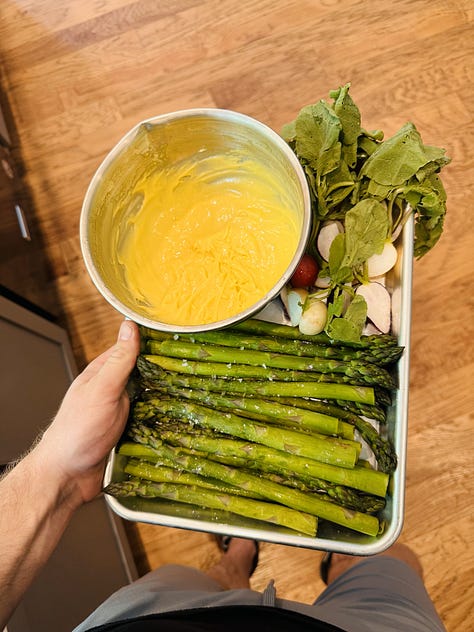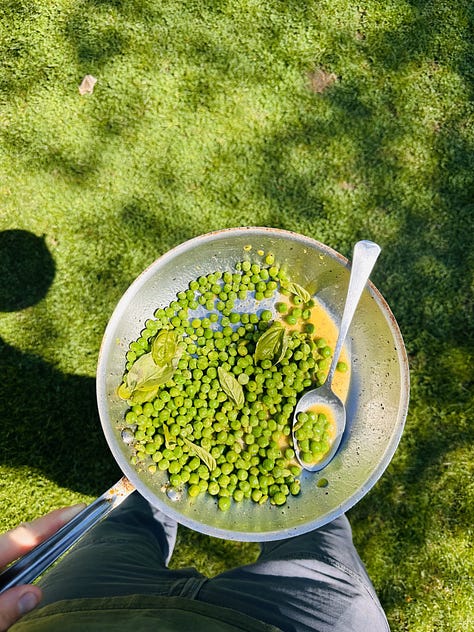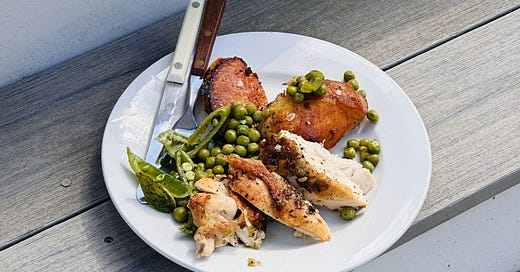the only recipe you need for a spring chicken is a vibe
We are officially in the “have you heard of ramps?” part of the year and I have to be honest I am exhausted by it. But my excitement will always supersede my exhaustion. Ramps are cool! Ramps taste good! But in the world of spring alliums I really don’t think they are the best or the most efficient.
Green garlic is one of the most magical things to ever be grown on earth. Green garlic, for the class, is young garlic. Green garlic is garlic that has not developed its bulb; its stalk is completely edible, while its bulb is completely entrenched as one big garlic clove. It’s an intense experience to eat it for the first time, but the ability to swap garlic out for green garlic in your spring meals will have you counting down the days every year.
The best way to enjoy spring, and everything spring has to offer is to amuse bouche your way through it. And I will always go to the underrated vegetables of spring, ones that don’t get their due and are waiting on the farmers stand to get picked. Asparagus and radishes are great, incredible even, but what about the salad turnips, the parsnips, THE KOHLRABI! They deserve the spring love.



The crux of it all is the spring chicken. Chicken, roasted simply, with salt, pepper and lemon and eaten with all of the bounty you have gathered. A bite of chicken, a swipe of radish in butter or crunch of a perfectly dressed piece of lettuce. This is the best part of cooking! And I will always tell people that recipes are guidelines. Nobody will know if you go your own way, take a leap, try something new.
I have a few opinions about chickens and how to roast them. I am a minimalist when it comes to cooking but specifically when it comes to technique. I have never and maybe will never (you never know i’m still growing) trussed a chicken at home. It has never made a difference in my life, and I doubt it will make a difference in yours.
The basic tenets of roasting chicken are this - salt, pepper and fat. If you have these three things, and only these three things, you will have a great roasted chicken. But you can do more.
Compound butter, stuffing (not bread based) and other roasted sidekicks. New potatoes, leeks, radishes and other hearty roasting vegetables to make this into a meal. The chicken I roasted was rubbed down in a garlic (green garlic) and herb butter (tarragon) and stuffed with half a lemon and other scraps lying around the kitchen, like that weird quarter of an onion you don’t know what to do with. 400 degrees for an hour to an hour and 20 minutes for 3 ½ lb. to 4 ½ lb. bird. The meat should be coming apart from the legs and the skin should be browned (reading 165 internal at the deepest part).
Despite popular belief, chicken cooking for a longer time doesn’t actually make it tougher. The proteins break down, the bones insulate the heat and the more you roast alongside your chicken, the more protected your chicken will be.
People are so afraid to roast chicken because it sounds daunting. The truth is, it is incredibly hard to mess up. The best thing you can do this spring, to celebrate what people grow with their own hands, is to celebrate with a meal. Push your limits; go to the farmers market and get that vegetable that you don’t know how to pronounce and most importantly - roast that chicken.









